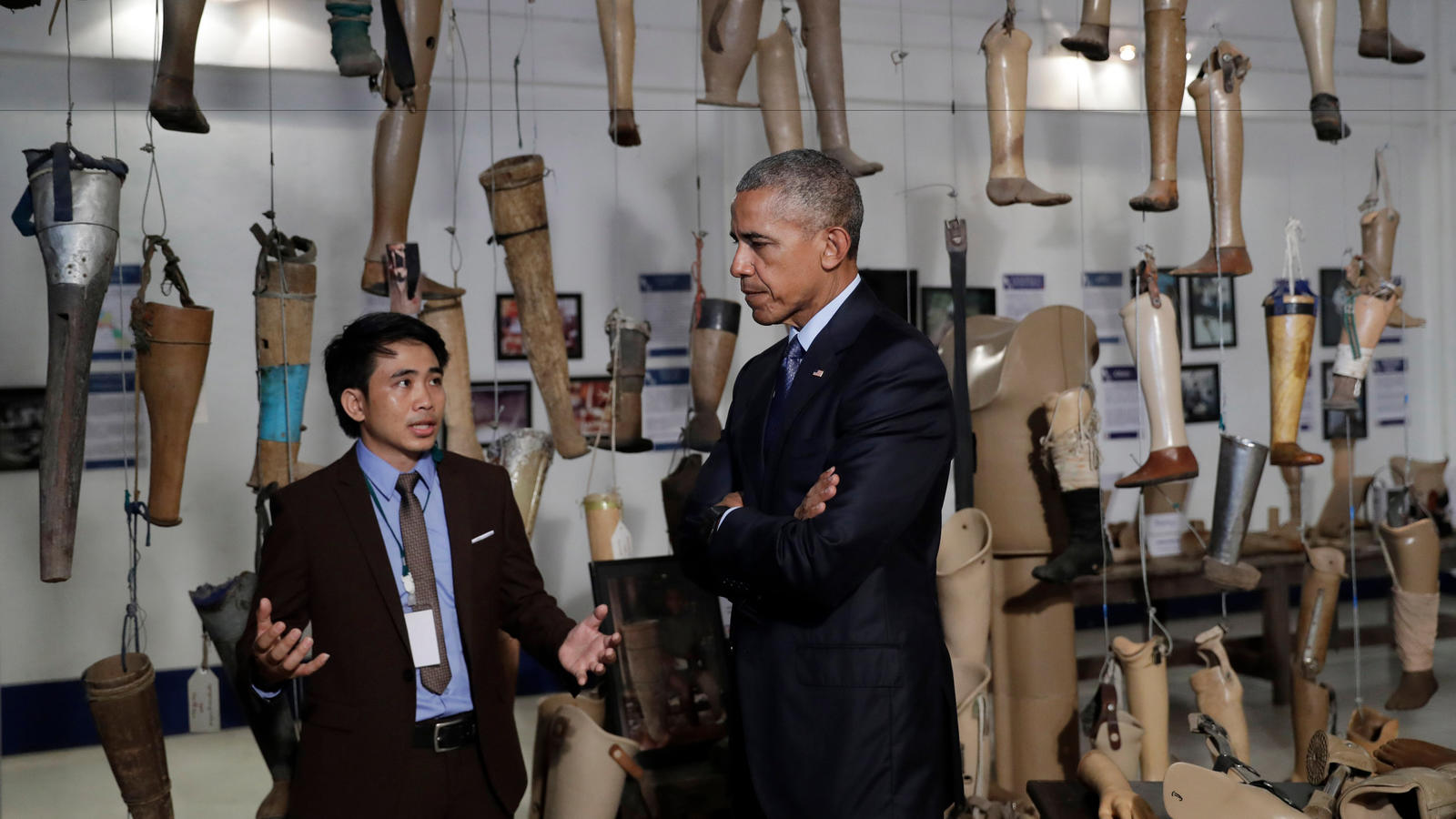Eight-year-old Thoummy Silamphan wanted bamboo shoots for his family’s soup, so he went into a field near his village, spotted some good ones and started digging in the soil with his hands.
What he also found that day 20 years ago was an American bomb left over from the Vietnam War era that had fallen from the sky but never detonated. It exploded, obliterating his left hand and knocking him flat into the field of shoots until neighboring farmers carried him to safety.
“I knew about the bombs,” he said this week, “but I didn’t have a choice. We have to go out into the fields anyway.”
On Wednesday, Silamphan went to the center here where other survivors are treated for their wounds to meet the president of the United States, five decades after the U.S. dropped 270 million cluster munitions on Laos to cut off enemy supply lines to the Viet Cong in a CIA-run operation that was kept secret from Americans.
President Obama did not apologize for the bombings that left an estimated 80 million baseball-sized undetonated explosives all over Laos. But as the first U.S. leader to visit the country and pay tribute to victims of the so-called bombies, he acknowledged them in a way that no predecessor had.
“We’re a nation that was founded on the belief in the dignity of every human being,” Obama said. “That belief has to lead us to value the life of every young Lao boy and girl, who deserve to be freed from the fear of the shadow of a war that happened long ago.
“Acknowledging the history of war,” he said, “is a way that we make future wars less likely.”
The visit was part of a legacy-of-war tour that Obama has been making in his last year in office, traveling to Vietnam and Japan this spring and now to Laos. “Confronting history,” Obama calls it.
This stop carried its own variety of sorrow, as many of the 20,000 people killed or wounded by the ordnance were children. The bombies look like balls, for play.
Silamphan was looking for food, not toys, as he walked home from his primary school in the Xieng Khuang province, on a plateau near the border with Vietnam.
People working in the farm fields around his home heard the explosion. The farmers came running and carried him to his family, who immediately took him to the hospital.
For years after the accident, Silamphan felt shame about his missing hand. He looked at others around him. “Their bodies were perfect,” he said, and he didn’t want to be around them. For a while, he refused to go back to school.
Eventually, he met an older boy who was also missing a hand, and he urged Silamphan to return to the classroom. The bomb had taken his hand, the boy told Silamphan, but it shouldn’t take his life.
Silamphan went on to study business and earn a master’s degree. Now 29, he runs the Quality of Life Assn., a foundation that helps survivors get treatment, prosthetics and social services.
His story has inspired others to work for the cause, among them Channapha Khamvongsa, a Lao American who met Silamphan a few years ago on a visit back to the country she and her parents left as refugees when she was young.
“It made me realize there was so much more the U.S. could do to support the people of Laos to recover and heal from the physical and emotional toll of war,” said Khamvongsa.
She formed her own group, Legacies of War, to raise awareness in the U.S. about the unexploded bombs in Laos.
Among those who heard about the effort was Ben Rhodes, a deputy national security advisor to Obama. Dispatched by the president to explore ways to strengthen U.S. ties to southeast Asia last year, he met with survivors of the bombs.
They sat in a circle, some with burn scars, some missing limbs, and told him their stories. Rhodes promised to tell Obama.
Some did not know who Rhodes was talking about. They were surprised enough to meet an American who wanted to talk about the unexploded ordnance.
“It’s wrong that the American people were not told about our bombing campaign in Laos,” Rhodes told them, recounting the episode this week in an interview.
“They knew that, that they were the forgotten part of the Vietnam War.”
In Laos this week, Obama announced the U.S. will provide $90 million over the next three years for finding the munitions and clearing them out, an increase over the $3-million yearly commitment in place when Obama took office.
One simple thing the U.S. government plans to do is to search Pentagon records of the bombings to help determine where unexploded ordnance may be concentrated.
At present, bomb finders, mostly women, wander fields with metal detectors in search of the balls. Some are lying out in the open; others were plowed into the ground. Cluster munitions are exposed through careful digging and then blown up where they are.
Obama also asked for help in finding the remains of U.S. servicemen whose planes were shot down over Laos as they were dropping those bombs, and the Laotian government agreed.
On his visit Wednesday to the Cooperative Orthotic Prosthetic Enterprise, or COPE, Obama met Silamphan.
Around them, prosthetic legs of different sizes, some with socks on, hung from the ceiling. Nearby was a basket of crutches.
“History does not have to drive us apart; it can sometimes pull us together,” Obama told reporters afterward. “Addressing the most painful chapters in our history honestly and openly can create openings.”
Silamphan only hopes the U.S. effort will aid victims.
“We can’t forget what they’ve been through,” he said.
Source: Los Angeles Times



